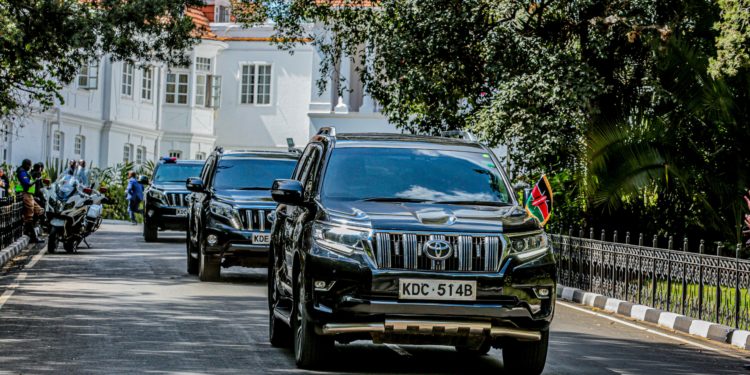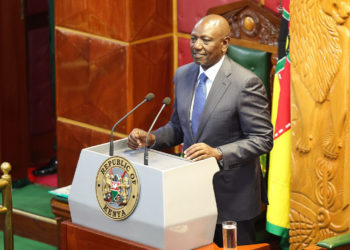The government has introduced a draft transport policy aimed at cutting costs and improving efficiency across its fleet of vehicles. The Government Transport Policy, 2024 proposes sweeping reforms to streamline operations, reduce fuel consumption, and curb mismanagement of public transport resources, which have strained the national budget for years.
The policy, which is awaiting formal approval, introduces strict measures to professionalize government fleet management, including the creation of a centralized Government Fleet Management Department (GFMD) and the adoption of modern technologies like electric vehicles (EVs) and fleet management systems with geo-fencing capabilities. The draft, prepared by the National Treasury, targets ministries, departments, agencies, and county governments, aiming to address operational inefficiencies and rising costs.
“The government transport system in Kenya faces numerous challenges such as fuel misuse, high maintenance costs, and obsolescence that have negatively impacted service delivery,” the draft policy states. “This policy seeks to address the perennial bottlenecks in government fleet operations.”
New Department to Oversee Fleet Management
Central to the policy is the establishment of the GFMD, which will be housed under the National Treasury. This new department will oversee all aspects of fleet management, including vehicle procurement, maintenance, and disposal. The GFMD is designed to resolve long-standing issues caused by the fragmented management of government vehicles, where different ministries and agencies managed their fleets independently, leading to duplication, inefficiencies, and a lack of accountability.
The policy mandates the GFMD to implement a comprehensive fleet management system that includes real-time vehicle tracking through geo-fencing technology. The system will ensure that all government vehicles are used efficiently, reducing misuse and cutting down on maintenance and operational costs. “This department shall be a fully-fledged entity with authority to oversee government transport,” the policy outlines.
Additionally, the policy aims to bring uniformity and accountability to fleet acquisition, utilization, and disposal. All surplus or underused vehicles will be assigned to a vehicle pool for optimal distribution among government offices. “By consolidating fleet management under the GFMD, the government will ensure accountability, cost-effectiveness, and improved service delivery,” the draft notes.
Engine Capacity Limits to Curb Costs
The policy imposes stringent limits on the engine capacities of official vehicles used by high-ranking government officials to reduce fuel consumption and maintenance expenses. Vehicles allocated to Cabinet Secretaries, the Speakers of the National Assembly and Senate, the Chief Justice, the Attorney General, the Secretary to the Cabinet, and the Head of Public Service will now be capped at 2,600cc for saloon cars and 3,000cc for 4×4 utility vehicles.
For Principal Secretaries, Accounting Officers, Judges of the Supreme Court and Court of Appeal, the Director of Public Prosecutions, the Clerk of the National Assembly and Senate, Heads of Constitutional Commissions, and the Inspector General of Police, the limit will be 2,400cc for saloon cars and 3,000cc for 4×4 vehicles.
Other senior government officers, including those in Job Group R and above, High Court Judges, and CEOs of state corporations, will be restricted to vehicles with 2,000cc for saloon cars and 2,900cc for 4×4 utility vehicles. These engine capacity restrictions are part of broader austerity measures to curb the growing cost of government transport.
Leasing Program Expansion
To further reduce capital outlays, the policy expands the government’s vehicle leasing program, which was initially launched in 2013. Under this program, the government will lease vehicles for a period of four years or 160,000 kilometers, whichever comes first, instead of purchasing them outright. This leasing model will include comprehensive maintenance packages, asset tracking, and the replacement of critical components like tires and batteries.
“The leasing programme provides an opportunity for officials to access tailor-made vehicles without the strain of huge capital outlay associated with outright purchase,” the policy states, highlighting its cost-effectiveness. The expanded program is also expected to support the growth of Kenya’s local motor vehicle assembly industry, create jobs, and enhance the capacity for local content in vehicle parts manufacturing.
Payments for leased vehicles will be spread across 16 quarterly lease rentals, ensuring predictable budget allocations for the government while maintaining flexibility in vehicle usage. By extending the leasing program, the government hopes to significantly cut down on maintenance and replacement costs for its fleet, which have been among the highest areas of expenditure.
Electric Vehicles to Cut Fuel Costs
In a bid to modernize the fleet and reduce environmental impact, the policy calls for the adoption of electric vehicles (EVs) in non-operational areas. The government plans to deploy EVs across ministries and agencies, with a focus on cutting fuel consumption and maintenance costs. In addition, the policy outlines a plan to build 1,000 EV charging stations, with 700 in urban centers and 300 along highways, to support this transition.
The shift toward electric vehicles is part of a larger push to decarbonize government fleet operations and align with the Bottom-Up Economic Transformation Agenda (BETA). By reducing reliance on fossil fuels, the government hopes to lower the environmental footprint of its transport services and contribute to Kenya’s climate change goals.
“Decarbonizing fleet operations will reduce carbon emissions and achieve energy transition goals,” the policy explains. The adoption of electric vehicles is also expected to significantly lower operational costs, as electric vehicles are generally cheaper to maintain and fuel compared to traditional combustion engine vehicles.
Tight Controls on Vehicle Allocation, Disposal, and Air Travel
The policy introduces new guidelines for vehicle allocation to government officials. Under the proposed rules, each Cabinet Secretary will be allocated two vehicles, while Principal Secretaries, county governors, and heads of state corporations will be allocated one vehicle each. Senior officers not covered by these allocations will have access to vehicles from a government pool to reduce under-utilization.
Additionally, the policy outlines strict disposal mechanisms to prevent the wasteful retention of aging vehicles. Government vehicles will be disposed of after six years or 160,000 kilometers, whichever comes first, with disposals conducted through public auctions in line with the Public Procurement and Disposal Act (2015). Vehicles that are beyond repair or lacking proper documentation will be sold as scrap.
Beyond vehicle management, the draft policy also introduces measures aimed at controlling air travel costs. In an effort to curtail excessive expenditure on flights, business-class travel will now be restricted to Cabinet Secretaries (CSs) and Principal Secretaries (PSs). All other government officials, regardless of their rank, will be required to fly economy class for both domestic and international trips.
The policy further mandates that hired air transport, such as chartered flights, will only be allowed in exceptional circumstances, such as for security reasons or emergencies. Additionally, it prioritizes the use of Kenya Airways, the national carrier, for official travel whenever possible.


















